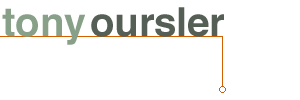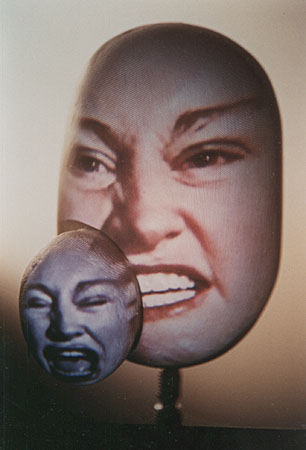

In Tony Oursler's most recent video exhibition the audience is barraged by the presence of thirteen eyes, all staring vacantly out of white hollow orbs that cower in corners and hover at eye level around the darkened gallery. Some eyes gaze out unblinking, one is overcome by a wash of tears and another jerks back and forth rapidly as if tracking prey. Upon closer inspection it becomes apparent that each eye is held enraptured by the flickering image from a television set. Whether press conferences, porno films or poetic channel surfing; the distant reflection off the screen is milkily visible on the eye of the original beholder, evoking an unsettling collapse of media and ego.
While the thirty nine year old video/ installation artist has received critical acclaim and attention abroad for quite some time, it is only now that a State-side audience is tuning in to his video projections. These recent, spellbound eyes are a departure from Oursler's previous talking head, video/figures that combined limp forms constructed of empty suits, or stuffed dolls with video projections of human faces beamed onto the figures. Projected onto the pathetic features of the vague figures, the video faces take on a desperate quality, as if trying to escape the bounds of the withered "flesh". Voices emanate from the video lips, bespeaking multifaceted portraits of psychological pain. "What are you looking at? ... Get away from me. I'll kick your ass." growls a peevish figure lying prostate on the floor, head squashed beneath a mattress.
These are no ordinary dolls - not ones one would ever want to cuddle up with on a bleak, stormy night. Instead of protecting us from the bogeyman, these figures are the bogeyman. In the spot where the video geist is projected onto the lifeless figure or into the hollow orb, we begin to realize, in burps and false starts, that these images are distilled versions of ourselves - informed and mutated by the ever-present video feed of television. Oursler seems to be illustrating the split our egos have taken, unearthing the multiple personalities that have developed as the culture digests the identities of endless television characters. In a society that has become immune to our own reflection as seen through the gaze of the video camera, Oursler asks us how we can reconcile ourselves with this reflected, disembodied image?
In accordance
with his figures, we assume the task of sublimation through TV projection,
identifying with the characters we encounter via the media. But with these
bogeymen Oursler subtly warns of a permanent psychological split, rendered
by the constant flow of garbled dialogue and psychic aggression that his
static bodies emit. These existential victims of video violence function
like crudely fashioned reflections of our own fracturing. They bespeak
a society that worships the media spectacle at the cost of its own collapse;
by way of rapid fire editing and high stakes channel surfing.
Amy Stafford © 1997